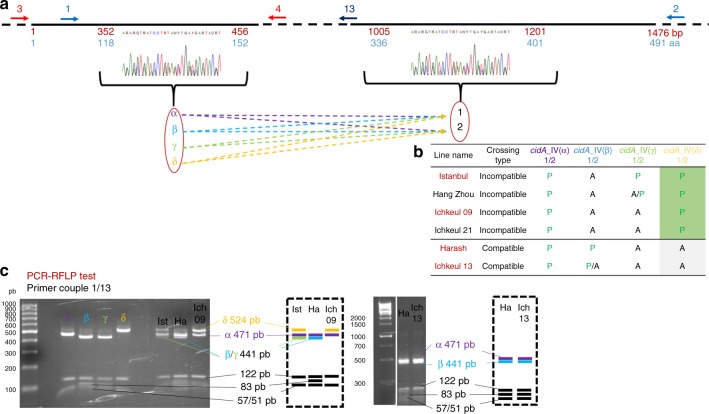Fig. 7.
cidA_IV gene polymorphic regions and PCR-RFLP tests for specific variants. a Schematic representation of the architecture of cidA_IV polymorphism. The black line represents the cidA_IV sequence with a focus on the two polymorphic regions. Non-polymorphic regions were shortened and represented as a dashed line. Numbers in red under the line represent nucleotide positions, and the numbers in blue indicate amino-acid positions. The overlapping oligonucleotides used for PCR amplification are represented by arrows numbered as in Supplementary Table 2. Both polymorphic regions were studied, but only the upstream matched the compatibility profile; its four different sequences (α, β γ, and δ) were followed by one of the two possible sequences (1 or 2) in the downstream polymorphic region. A different color code was used for α (purple), β (light blue), γ (light green), and δ (yellow) sequences in the upstream part of the cidA gene. b The repertoire of cidA_IV variants is different in “compatible” and “incompatible” lines. cidA_IV(δ) is present only in lines with “incompatible” crossing type. The names of the C. pipiens lines used to set-up the PCR-RFLP (c) test are highlighted in red. c PCR-RFLP tests for distinguishing between cidA_IV variants on the basis of the upstream polymorphic region. A 778 bp fragment was amplified with primers 1/13. Double digestion with ApoI and Hpy188I distinguished between cidA_IV(α) (six fragments: 471; 122; 57; 53; 51; and 24 bp), cidA_IV(β) and cidA_IV(γ) (six fragments: 441; 122; 83; 57; 51; and 24 bp), and cidA_IV(δ) (five fragments: 524; 122; 57; 51; and 24 bp). Panel to the left of the electrophoresis gel: PCR-RFLP on DNA from clones; right panel: PCR-RFLP on DNA from the Istanbul, Harash, Ichkeul 13, and Ichkeul 09 lines. On the right of the gel, a schematic representation of the PCR-RFLP profiles of these lines. Digestion bands that are specific of the variants are represented with the color code established in a. Bands that are not used to discriminate between the variants are represented in black on the bottom of the schematic gel

